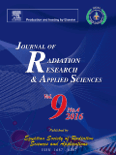
Journal of Radiation Research and Applied Sciences
Scope & Guideline
Pioneering research that bridges theory and practice in radiation science.
Introduction
Aims and Scopes
- Medical Imaging Techniques:
The journal explores advancements in medical imaging, including the use of MRI, CT, and ultrasound technologies, focusing on improving diagnostic accuracy and patient outcomes. - Radiation Therapy and Oncological Applications:
Research published in the journal often investigates the efficacy and safety of radiation therapy techniques, aiming to enhance treatment protocols for various cancers. - Radiation Shielding and Safety:
A significant focus is placed on the development and analysis of materials for radiation shielding, assessing their effectiveness in protecting individuals and the environment from harmful radiation exposure. - Nanotechnology and Radiobiology:
The journal features studies on the application of nanotechnology in radiation research, particularly in enhancing the effectiveness of radiotherapy and developing new radioprotective agents. - Environmental Radiation Studies:
Research in this area assesses natural and artificial radiation levels in various environments, addressing public health implications and regulatory compliance. - Artificial Intelligence and Machine Learning in Radiology:
The integration of AI and machine learning techniques in medical imaging and radiation therapy is a prominent theme, focusing on improving diagnostic processes and treatment planning.
Trending and Emerging
- Artificial Intelligence in Radiology:
The use of AI and machine learning for image analysis, diagnostics, and treatment planning is rapidly expanding, indicating a shift towards technology-driven approaches in radiology. - Personalized Radiation Therapy:
Research focusing on tailoring radiation therapy protocols to individual patient characteristics is trending, emphasizing the need for precision medicine in oncology. - Radioprotection and Bioprotective Agents:
There is an increasing interest in the development of novel bioprotective agents and methods to mitigate radiation-induced damage, particularly in the context of cancer therapy. - Hybrid Imaging Techniques:
The integration of multiple imaging modalities (e.g., PET/CT, MRI-guided radiation therapy) is becoming more prevalent, enhancing diagnostic capabilities and treatment efficacy. - Environmental and Occupational Radiation Studies:
Research on the effects of radiation exposure in environmental contexts and occupational settings is gaining importance, reflecting growing public health concerns. - Advancements in Radiological Safety Protocols:
Emerging studies are focusing on improving safety protocols in radiology departments, especially in light of increased radiation use during the COVID-19 pandemic.
Declining or Waning
- Traditional Radiological Techniques:
There has been a noticeable decline in research dedicated to conventional radiographic techniques, as newer imaging modalities and technologies gain traction. - Basic Radiation Physics:
Exploratory studies focused solely on fundamental aspects of radiation physics are becoming less frequent, giving way to more applied research that integrates technology and clinical practice. - Single-Dimensional Radiation Dosimetry:
Research centered on traditional dosimetry methods without integrating advanced computational models or multi-dimensional approaches is waning, as the field moves towards more comprehensive dosimetric evaluations. - Generalized Epidemiological Studies:
Broad epidemiological studies related to radiation exposure are less common, as the focus shifts to more targeted investigations examining specific populations or conditions.
Similar Journals

RADIATION PHYSICS AND CHEMISTRY
Bridging Theory and Application in Radiation ResearchRADIATION PHYSICS AND CHEMISTRY, published by Pergamon-Elsevier Science Ltd in the United Kingdom, stands as a leading journal in the field of radiation studies, bridging fundamental research and practical applications. With an impressive 2023 Scopus Rank of 11 out of 58 in the Radiation category, reflecting an 81st percentile ranking, the journal maintains a robust reputation within the scientific community. The journal focuses on the experimental and theoretical aspects of radiation physics, chemistry, and their interdisciplinary applications, providing critical insights that aid the advancement of knowledge in various domains, including nuclear energy, materials science, and healthcare. Although open access options are not available, the journal garners substantial readership and engagement from researchers, professionals, and students alike, as it publishes innovative studies and reviews from 1985 through to its anticipated conclusion in 2025. The ISSN for the journal is 0969-806X, with the E-ISSN being 1879-0895, ensuring global accessibility to cutting-edge research in radiation science.
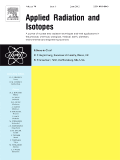
Applied Radiation and Isotopes
Connecting Researchers to the World of Radiation and IsotopesApplied Radiation and Isotopes is a premier journal dedicated to the dissemination of high-quality research in the fields of radiation and isotopes, published by PERGAMON-ELSEVIER SCIENCE LTD. With a commendable impact factor reflecting its respected standing, this journal ranks in the Q3 category within Radiation according to the 2023 evaluation, emphasizing its relevance in the scientific community. Operating out of the United Kingdom, it has been a crucial platform for innovation and knowledge sharing since its inception, covering a wide array of applications ranging from the medical to the industrial sectors. Researchers can access a wealth of articles through its online platform, although it currently does not offer open access options. Applied Radiation and Isotopes is thus an essential resource for researchers, professionals, and students aiming to stay abreast of the latest developments in radiation physics and isotopic applications, making impactful contributions to the field.
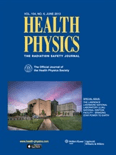
HEALTH PHYSICS
Elevating Standards in Health Physics ResearchHEALTH PHYSICS is a leading academic journal dedicated to the study and dissemination of knowledge in the fields of radiology, epidemiology, and health toxicology. Published by Lippincott Williams & Wilkins, this esteemed journal has been a cornerstone of research since its inception in 1958, and it continues to foster important discussions and advancements in the discipline. With a notable impact factor and consistently ranking in the Q2 and Q3 quartiles across various categories in 2023, HEALTH PHYSICS serves as a vital resource for scholars, practitioners, and students seeking the latest insights and methodologies in the management of radiation exposure and its health implications. While the journal does not offer open access, it remains a critical platform for peer-reviewed articles that contribute to public health and environmental safety. The journal's comprehensive scope and historical significance underscore its importance in advancing knowledge and practices within its field, making it an essential read for anyone engaged in the multidisciplinary realms of health physics.

Journal of Radiation Protection and Research
Bridging Science and Practice in Radiation ProtectionJournal of Radiation Protection and Research, published by the Korean Association of Radiation Protection (KARP), serves as a pivotal platform for disseminating innovative research in the fields of radiation safety and health-related issues. With an ISSN of 2508-1888 and an E-ISSN of 2466-2461, this South Korea-based journal aims to bridge the gap between scientific research and practical application, emphasizing radiation protection, environmental health, and public safety. Though categorized in Q4 for Health, Toxicology and Mutagenesis, and Q3 for several other scopes as of 2023, the journal is dedicated to publishing high-quality studies that contribute to the improvement of safety standards and methodologies in radiation practice. The journal also provides valuable insights for practitioners in the healthcare and environmental sectors, making it an essential resource for researchers, professionals, and students alike who aspire to advance their understanding and application of radiation science. As the field evolves, so does the Journal of Radiation Protection and Research, which seeks to foster a collaborative and innovative academic community dedicated to ensuring safe and effective radiation use.
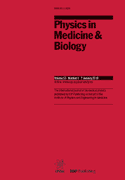
PHYSICS IN MEDICINE AND BIOLOGY
Innovating Healthcare Through Physics and BiologyPHYSICS IN MEDICINE AND BIOLOGY is a prestigious journal published by IOP Publishing Ltd, with a storied history dating back to 1956 and extending through 2024. This internationally recognized journal caters to the interdisciplinary fields of medical physics and bioengineering, making significant contributions to the research and development of advanced diagnostic and therapeutic technologies. It holds an impressive Q1 ranking in both Radiological and Ultrasound Technology and Radiology, Nuclear Medicine and Imaging categories, reflecting its critical role in disseminating high-quality research. With a significant focus on merging the principles of physics with advancements in medicine, PHYSICS IN MEDICINE AND BIOLOGY serves as an essential resource for researchers, professionals, and students alike, fostering innovation and enhancing collaboration in the healthcare sector. Although the journal is not currently open access, it maintains robust participation in the Scopus database, ranking #62 out of 333 in Radiology, Nuclear Medicine and Imaging and #17 out of 63 in Radiological and Ultrasound Technology, signifying its influence and reach within these disciplines.
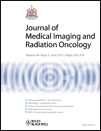
Journal of Medical Imaging and Radiation Oncology
Advancing the Frontiers of Medical Imaging and OncologyJournal of Medical Imaging and Radiation Oncology, published by WILEY, is a pivotal resource in the fields of oncology and medical imaging. With an impact factor reflective of its commitment to advancing research, the journal has maintained a robust reputation since its inception in 2008 and continues to thrive through 2024. It is indexed with an insightful ranking, with a Q2 classification in Radiology, Nuclear Medicine and Imaging, affirming its importance in these disciplines. This journal not only serves as an open access platform, allowing extensive reach and accessibility, but also fosters a scholarly community dedicated to the innovation of imaging techniques and radiation oncology practices. As a key player in disseminating crucial findings and advancements, it appeals to researchers, clinicians, and students who aim to contribute to the evolving landscape of medical imaging and cancer treatment methodologies. The journal is based in Australia, at 111 River St, Hoboken, NJ, and invites submissions that push the boundaries of current knowledge in this critical area of healthcare.
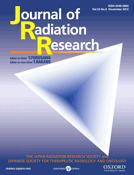
JOURNAL OF RADIATION RESEARCH
Advancing knowledge in radiation science since 1960.JOURNAL OF RADIATION RESEARCH, published by Oxford University Press, is a prominent peer-reviewed journal focusing on the diverse fields of radiation science, including health, toxicology, and radiology. Since its inception in 1960, this open-access journal has provided a critical platform for the dissemination of high-quality research, making it accessible to a global audience of researchers, professionals, and students. With a consistent track record, the journal holds an impressive impact factor and is categorized in Q2 of Radiation studies and Q3 in Health and Toxicology as per the 2023 rankings, reflecting its influential role in shaping contemporary discourse in the field. The journal also boasts notable rankings within Scopus, further underscoring its importance in advancing knowledge and innovations related to radiation. Spanning from 1960 to 2024, the JOURNAL OF RADIATION RESEARCH remains at the forefront of scientific exploration and is essential reading for anyone committed to advancing the understanding of radiation and its effects.

International Journal of Radiation Research
Exploring the Frontiers of Nuclear Medicine ResearchThe International Journal of Radiation Research, published by the IJRR-IRANIAN JOURNAL RADIATION RES, serves as a critical platform for researchers and professionals in the fields of radiology, nuclear medicine, and imaging technology. Since its inception in 2003, this peer-reviewed, open-access journal has focused on disseminating significant findings and advancements, contributing to the global discourse on radiation research. With an ISSN of 2322-3243, the journal offers valuable insights into emerging technologies and methodologies, maintaining a commitment to enhancing the understanding and application of radiation in medical science. Although currently positioned in the Q4 category across its scopes, the journal strives to elevate its impact by promoting high-quality research and innovative practices. The journal is accessible to a wide audience and encourages submissions from scholars worldwide, directly supporting the advancement of knowledge in radiological and ultrasound technology. For those seeking to explore and contribute to this dynamic field, the International Journal of Radiation Research represents an invaluable resource.

Advances in Radiation Oncology
Connecting Ideas, Advancing OncologyAdvances in Radiation Oncology, published by Elsevier Inc, is a premier international journal dedicated to the field of oncology and radiology, focusing on the latest groundbreaking research and innovations in radiation therapy. Launched as an Open Access journal in 2016, it has since carved out a significant niche in the academic community, featuring contributions that span a diverse range of topics including clinical practices, technologies, and outcomes in radiation oncology. With an impressive Q2 rankingOncology and Radiology, Nuclear Medicine and Imaging categories for 2023, and positioned within the 65th and 55th percentiles of Scopus ranks, it serves as an essential resource for researchers, medical professionals, and students alike. The journal not only emphasizes the importance of disseminating knowledge widely through its open access model but also aims to foster collaboration and innovation in the evolving landscape of cancer treatment. For those looking to stay at the forefront of radiotherapy research and advancements, Advances in Radiation Oncology is an invaluable platform for scholarly communication.

Physics & Imaging in Radiation Oncology
Innovating Research to Illuminate the Path of Radiation OncologyPhysics & Imaging in Radiation Oncology is a premier journal dedicated to advancing the interdisciplinary field of radiation oncology through innovative research and imaging technologies. Published by Elsevier, this open-access journal has made its mark since its inception in 2017, ensuring that groundbreaking findings are accessible to a broad audience. With a strong focus on the integration of physics, imaging techniques, and oncology, the journal occupies esteemed positions in the academic landscape, ranking in the top quartile for Radiation and Radiology, Nuclear Medicine and Imaging as of 2023. The journal serves as a platform for researchers, professionals, and students to share insights and foster collaboration, ultimately improving patient outcomes through enhanced imaging and treatment modalities. Based in Ireland and operating from Radarweg 29, 1043 NX Amsterdam, Netherlands, the journal aims to bridge the gap between theoretical physics and practical applications in clinical settings.